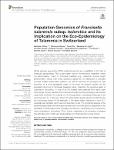Population Genomics of Francisella tularensis subsp. holarctica and its Implication on the Eco-Epidemiology of Tularemia in Switzerland
Wittwer, Matthias
Altpeter, Ekkehard
Pilo, Paola
Gygli, Sebastian M.
Beuret, Christian
Foucault, Frederic
Ackermann-Gäumann, Rahel
Karrer, Urs
Jacob, Daniela
Grunow, Roland
Schürch, Nadia
Whole genome sequencing (WGS) methods provide new possibilities in the field of molecular epidemiology. This is particularly true for monomorphic organisms where the discriminatory power of traditional methods (e.g., restriction enzyme length polymorphism typing, multi locus sequence typing etc.) is inadequate to elucidate complex disease transmission patterns, as well as resolving the phylogeny at high resolution on a micro-geographic scale. In this study, we present insights into the population structure of Francisella tularensis subsp. holarctica, the causative agent of tularemia in Switzerland. A total of 59 Fth isolates were obtained from castor bean ticks (Ixodes ricinus), animals and humans and a high resolution phylogeny was inferred using WGS methods. The majority of the Fth population in Switzerland belongs to the west European B.11 clade and shows an extraordinary genetic diversity underlining the old evolutionary history of the pathogen in the alpine region. Moreover, a new B.11 subclade was identified which was not described so far. The combined analysis of the epidemiological data of human tularemia cases with the whole genome sequences of the 59 isolates provide evidence that ticks play a pivotal role in transmitting Fth to humans and other vertebrates in Switzerland. This is further underlined by the correlation of disease risk estimates with climatic and ecological factors influencing the survival of ticks.
No license information

